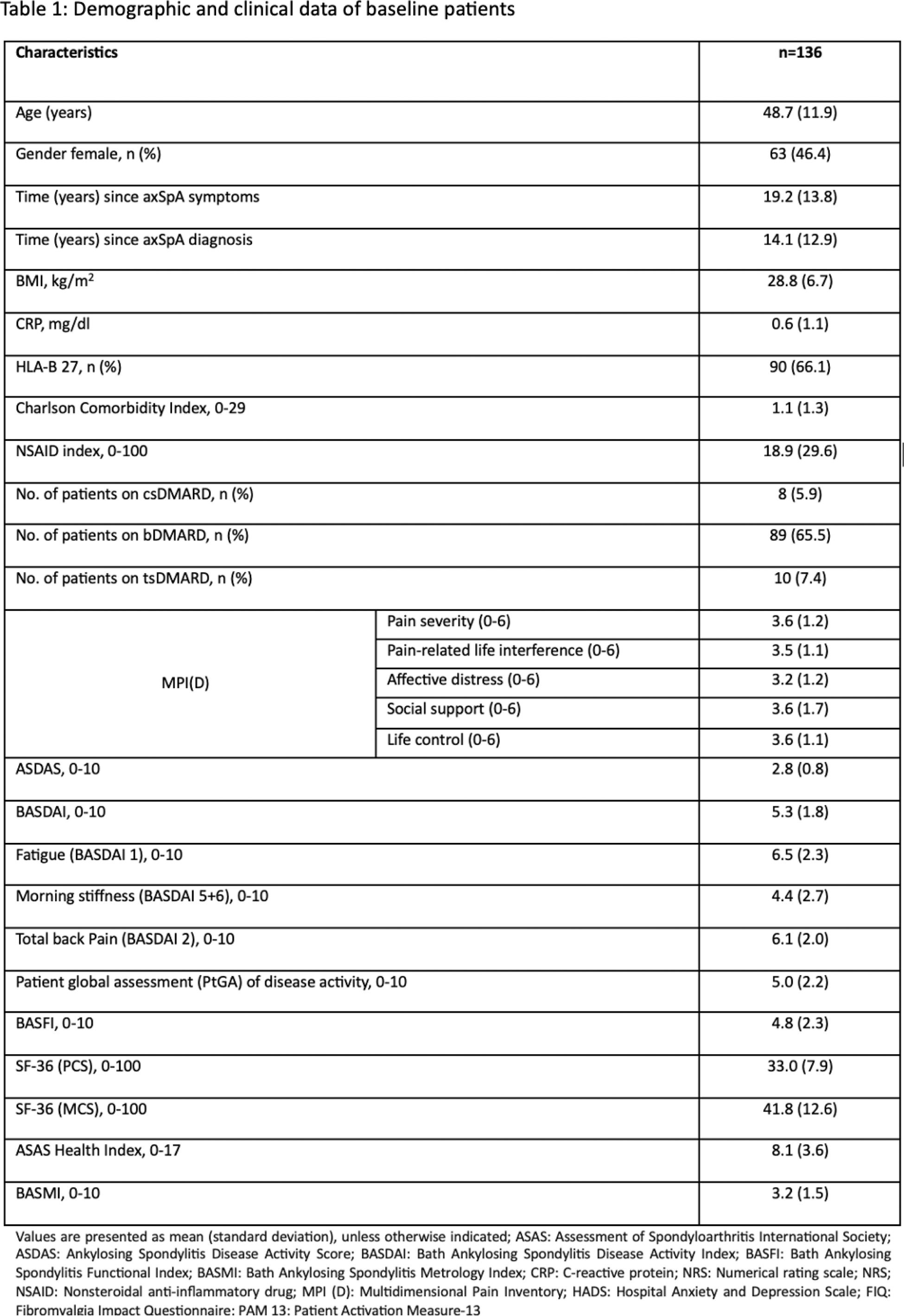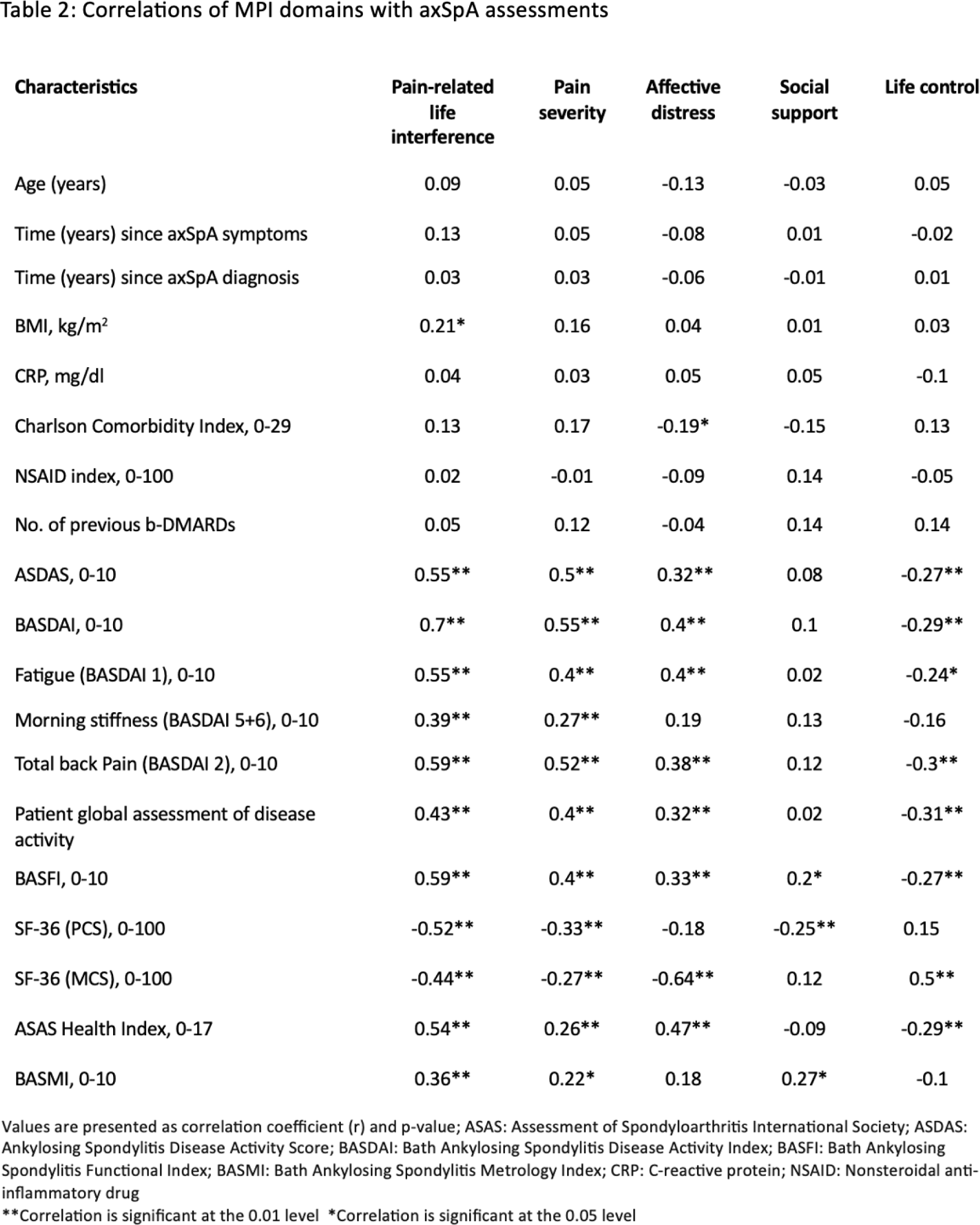

Background: The West Haven-Yale Multidimensional Pain Inventory (MPI) is a validated tool designed to assess the multidimensional aspects of chronic pain, including the 5 dimensions of pain: pain-related life interference, pain severity, affective distress, social support and life control. Originally developed in the US, the MPI has been successfully adapted and validated in German-speaking populations [1]. Chronic pain in rheumatic diseases often extends beyond inflammatory mechanisms, involving nociplastic and central sensitization components. Therefore, the MPI, with its biopsychosocial framework, offers an opportunity to explore these dimensions of pain in patients with axial spondyloarthritis (axSpA).
Objectives: To assess the construct validity of the MPI by examining its correlations with patient-reported outcomes (PRO) used in the Assessment of SpondyloArthritis international Society-Outcomes Measures in Rheumatology (ASAS-OMERACT) core domain set for clinical trials in axSpA [2].
Methods: The five MPI dimensions were assessed in axSpA patients with a pain score ≥ 4 (NRS 0-10) and results were correlated with assessments of the ASAS-OMERACT core domain set, including disease activity (ASDAS, CRP, BASDAI, patient global assessment (PtGA) of disease activity, physical function (BASFI), health-related quality of life (ASAS Hi, MCS and PCS of the SF36), total back pain and morning stiffness, and spinal mobility (BASMI) as well as demographic and clinical data using Pearson´s correlations. Correlations were classified as weak (r≥0.1), moderate (r≥0.3), and strong (r≥0.5) according to Pearson’s effect size interpretation.
Results: A total of 136 patients with axSpA were included and the MPI was completed by 109 (80.2%) patients (Table 1). Pain-related life interference showed significant strong correlations with ASDAS, BASDAI, BASFI, PCS, fatigue and total back pain while moderate correlations were found for PtGA of disease activity, MCS, morning stiffness, and BASMI. For pain severity, significant strong correlations were observed with ASDAS, BASDAI and total back pain. Moderate correlations were found with PtGA of disease activity, BASFI, PCS and fatigue, weak correlations were found with MCS, ASAS HI and morning stiffness. Affective distress showed strong correlations only with MCS and weak or moderate correlations with all other assessments, while social support only showed a weak correlation with the PCS and the BASMI but with no other PRO of the axSpA core outcome set. For life control, a strong positive correlation was only found with MCS whereas moderate negative correlations were found with PtGA of disease activity and total back pain and weak negative correlations with ASDAS, BASDAI, BASFI, ASAS HI and fatigue.
Conclusion: The MPI provides valuable insights into the multidimensional aspects of pain in axSpA. Pain-related life interference and severity demonstrated strong correlations, while affective distress and life control showed weak to moderate correlations with the ASAS core domain set and thereby demonstrating construct validity. Apart from a weak correlation of social support with the PCS, the domains of social support and life control are not yet fully captured in the axSpA core domain set or other commonly used PROs in axSpA trials.
REFERENCES: [1] Flor H, Rudy TE, Birbaumer N et al. [The applicability of the West Haven-Yale multidimensional pain inventory in German-speaking countries. Data on the reliability and validity of the MPI-D.]. Schmerz 1990; 4: 82-87. doi:10.1007/bf02527839.
[2] Navarro-Compán V, Boel A, Boonen A et al. The ASAS-OMERACT core domain set for axial spondyloarthritis. Semin Arthritis Rheum 2021. doi:10.1016/j.semarthrit.2021.07.021. doi:10.1016/j.semarthrit.2021.07.021.


Acknowledgements: This study was funded as part of the Research funding of the Faculty of Medicine - FoRUM program - at Ruhr-University Bochum, Germany.
Disclosure of Interests: David Kiefer: None declared, Yade Sonkaya: None declared, Dietmar Krause: None declared, Markus Voglau Abbvie, Pfizer, Novartis, Bernhard Mintrop: None declared, Imke Redeker: None declared, Xenofon Baraliakos: None declared, Uta Kiltz: None declared.
© The Authors 2025. This abstract is an open access article published in Annals of Rheumatic Diseases under the CC BY-NC-ND license (